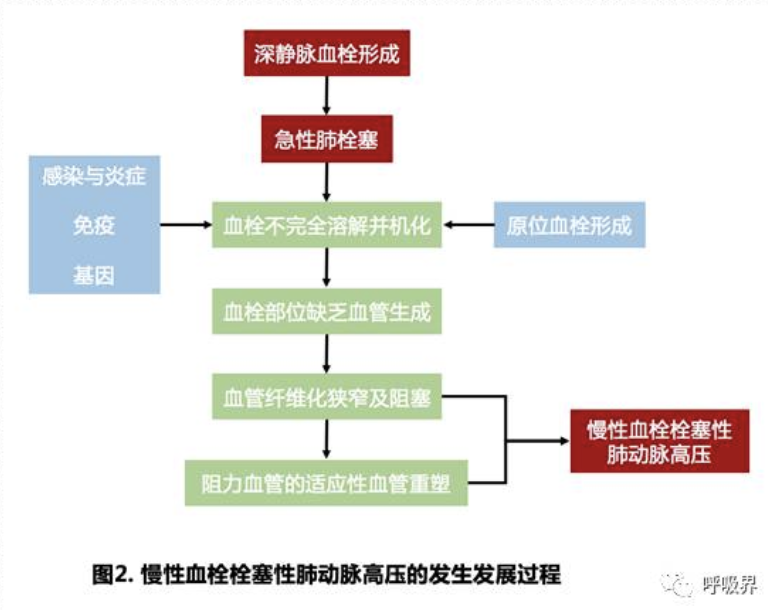一、肺栓塞与慢性血栓栓塞性肺动脉高压
肺血栓栓塞症(pulmonary thromboembolism,PTE,以下简称为肺栓塞)为来自静脉系统或右心的血栓阻塞肺动脉或其分支所致的疾病,引起PTE的血栓主要来源于深静脉血栓形成(deep venous thrombosis,DVT)。DVT与PTE实质上为一种疾病过程在不同部位、不同阶段的两种表现,二者合称为静脉血栓栓塞症(venous thromboembolism,VTE)。
慢性血栓栓塞性肺动脉高压(Chronic thromboembolic pulmonary hypertension,CTEPH),是指经过至少3个月的有效抗凝治疗后,右心导管检查测得平均肺动脉压力>25mmHg且肺动脉楔压≤15mmHg,核素肺通气-灌注显像中存在至少一个肺段的通气-灌注不匹配或CT肺动脉造影(CT pulmonary angiography,CTPA)、肺动脉造影显示至少一个肺段的造影剂灌注缺损(CTPA见图1所示)。作为肺动脉高压中的第四大类,它是PTE最为严重的远期并发症。

从流行病学数据来看,VTE与CTEPH之间存在着无法忽视的关联。据文献报道,症状性肺栓塞后2年CTEPH的发生率从0.1%到9.1%不等。[1-10]VTE复发是CTEPH发生的危险因素之一。[10] 在欧洲CTEPH注册登记研究中,分别有74.8%、56.1%的CTEPH患者有明确的肺栓塞、DVT既往史。[11]
二、肺栓塞如何发展为慢性血栓栓塞性肺动脉高压?
CTEPH是由机化的血栓长期阻塞肺动脉及其分支、远端血管重塑造成的肺血管阻力与肺动脉压力进行性升高,最终会进展为右心功能不全,乃至死亡。
当单次或多次反复发生PTE而血栓不能完全溶解时,血栓机化,缺乏新生血管,导致栓塞的血管出现纤维化所致的狭窄甚至阻塞,从而使阻力血管发生血管重塑,表现为血管中层平滑肌肥厚,外膜和内膜过度增殖,出现丛样病变等,这与动脉性肺动脉高压的病理改变相似。而感染与炎症反应、免疫反应、基因易感性及原位血栓形成在CTEPH的发生发展过程中亦发挥着重要的作用。(如图2所示)[12]

三、哪些肺栓塞患者容易发展为慢性血栓栓塞性肺动脉高压?
若不经治疗,CTEPH预后极差;而肺动脉血栓内膜剥脱术可治愈部分CTEPH(手术剥脱的血栓及内膜见图3)。在欧洲CTEPH注册登记研究中,发生最后一次PTE与进行肺动脉血栓内膜剥脱术的时间间隔是CTEPH患者病死的危险因素之一。[11] CTEPH的早期发现、早期诊断可以增加患者的手术机会,改善其预后。

那么哪些肺栓塞患者容易发展为CTEPH呢?目前已知的CTEPH危险因素包括:急性肺栓塞时存在右心功能不全、遗传性高凝状态(如FVIII水平升高、FV Leiden突变、抗磷脂综合征等)、炎性疾病(如炎性肠病、骨髓炎等)、甲状腺功能低下、脾切除病史、房室分流、起搏器植入术病史、复发性VTE。[13]
我国的一项研究[14]对614例急性肺栓塞患者进行了长期随访,中位随访期为3.3年,10例患者确诊为CTEPH,急性肺栓塞后1年、2年与3年CTEPH累积发生率分别为0.8%、1.3%与1.7%;下肢静脉曲张病史、肺栓塞急性期超声估测的肺动脉收缩压>50mmHg、急性肺栓塞3个月后CT阻塞指数>30%为CTEPH的危险因素。
对于存在上述CTEPH危险因素的PTE患者,临床医生应给予足够的重视和规范化的治疗。PTE患者如应用华法林抗凝,应定期监测国际标准化比值(international normalized ratio,INR),根据目标INR调节华法林剂量,尽量提高INR达标率以确保抗凝效果。而抗凝疗程则应根据患者发生PTE是否存在明确的诱发因素、诱发因素是一过性还是永久性、是否存在残存血栓等情况并结合患者意愿综合考量。在对患者的随访管理中,可通过超声心动图、肺通气-灌注断层(V/Q)显像、CTPA、心电图、NT-proBNP等生物标志物、心电图联合生物标志物、临床预测评分等手段在PTE患者中筛查CTEPH,实现早期诊断。
【参考文献】
1.Fedullo PF, Auger WR, Kerr KM, et al. Chronic thromboembolicpulmonary hypertension. N Engl J Med 2001; 345: 1465–1472.
2.Becattini C, Agnelli G, Pesavento R, et al. Incidence of chronic thromboembolic pulmonary hypertension after a first episode ofpulmonary embolism. Chest 2006; 130: 172–175.
3.Benotti JR, Ockene IS, Alpert JS, et al. The clinical profile ofunresolved pulmonary embolism.Chest 1983; 84: 669–678.
4.Klok FA, van Kralingen KW, van Dijk AP, et al. Prospective cardiopulmonary screening program to detect chronic thromboembolic pulmonary hypertension in patients after acute pulmonary embolism.Haematologica 2010; 95: 970–975.
5.Miniati M, Monti S, Bottai M, et al. Survival and restoration of pulmonary perfusion in a long-term follow-up of patients after acute pulmonary embolism. Medicine (Baltimore) 2006; 85: 253–262.
6.Ribeiro A, Lindmarker P, Johnsson H, et al. Pulmonary embolism: one-year follow-up with echocardiography doppler and five-year survival analysis. Circulation 1999; 99: 1325–1330.
7.Pengo V, Lensing AW, Prins MH, et al. Incidence of chronic thromboembolic pulmonary hypertension after pulmonary embolism. N Engl J Med 2004; 350: 2257–2264.
8.Dentali F, Donadini M, Gianni M, et al. Incidence of chronic pulmonary hypertension in patients with previous pulmonary embolism. Thromb Res 2009; 124: 256–258.
9.Surie S, Gibson NS, Gerdes VE, et al. Active search for chronic thromboembolic pulmonary hypertension does not appear indi- cated after acute pulmonary embolism. Thromb Res 2010; 125: e202–e205.
10. Marti D, Gomez V, Escobar C, et al. Incidence of symptomatic and asymptomatic chronic thromboembolic pulmonary hypertension. Arch Broncopneumol 2010; 46: 628–633.
11. E. Mayer, D. Jenkins, J. Lindner, et al. Surgical management and outcome of patients with chronic thromboembolic pulmonary hypertension: results from an international prospective registry, J. Thorac. Cardiovasc. Surg. 141 (3) (2011) 702–710.
12. Lang IM, Pesavento R, Bonderman D, Yuan JX.Risk factors and basic mechanisms ofchronic thromboembolic pulmonaryhypertension: a current understanding. EurRespir J 2013; 41: 462–468.
13. Medrek S, Safdar Z.Epidemiology and Pathophysiology of Chronic Thromboembolic Pulmonary Hypertension: Risk Factors and Mechanisms.Methodist DebakeyCardiovasc J. 2016 Oct-Dec;12(4):195-198
14. Yang S, Yang Y, Zhai Z, et al. Incidence and risk factors of chronic thromboembolic pulmonary hypertension in patients after acute pulmonary embolism. J Thorac Dis 2015;7(11):1927-1938.
【作者简介】

张帅 医学博士
中日友好医院呼吸与危重症医学科二部
end


